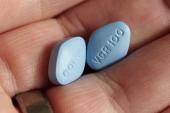Pills for Erectile Dysfunction Linked to Fewer CVD Deaths
Swedish registry data make the case for PDE5 inhibitors, but only an RCT can draw a definitive conclusion, experts say.

Men with stable CAD who are being treated for erectile dysfunction (ED) have a lower risk of dying if their medication is a phosphodiesterase 5 (PDE5) inhibitor rather than alprostadil, observational data from Sweden show. Additionally, treatment with a PDE5 inhibitor was associated with a significantly lower risk of MI, revascularization, hospitalization for HF, and cardiovascular mortality when compared with alprostadil.
The results lend support to the idea that there’s something uniquely beneficial to PDE5 inhibitors, Daniel P. Andersson, MD, PhD (Karolinska University Hospital, Stockholm, Sweden), and colleagues report in a paper published this week in the Journal of the American College of Cardiology.
“Vasculogenic ED has been proposed to be an early manifestation of atherosclerosis and to precede presentation of coronary artery disease,” they explain. “Men with ED have been identified as a high-risk population for incident cardiovascular disease. Conversely, treatment for ED is associated with a lower risk of death and development of cardiovascular disease.”
The link between treatment and outcome was confirmed in a previous analysis by the same group that looked at men who’ve had a first MI, some of whom weren’t receiving any drug to address ED.
This time around, the researchers focused on men with stable CAD who were being treated for ED with either a PDE5 inhibitor or alprostadil, in case there was something different between those who did or didn’t seek treatment, said senior author Martin J. Holzmann, MD, PhD (Karolinska University Hospital).
Ask patients with coronary artery disease if they have erectile dysfunction. It’s so common and it’s treatable. Martin J. Holzmann
PDE5 inhibitors, whether sildenafil, tadalafil, or vardenafil, are given orally. Alprostadil, in contrast, is a vasodilator applied locally that wouldn’t exert systemic effects. He cautioned that this doesn’t eliminate the potential for “confounding by indication,” due to differences between who’s taking PDE5 inhibitors versus alprostadil.
In fact sildenafil, the first PDE5 to market—as Viagra—was initially investigated for the treatment of hypertension and angina.
Dose-Response Association Seen
Using data from the Swedish Patient Register and the Swedish Prescribed Drug Register, the investigators compared 16,548 men treated with a PDE5 inhibitor and 1,994 treated with alprostadil. The data set spanned from 2006 through 2013. Patients taking alprostadil tended to be older, were more likely to have comorbidities (heart failure, diabetes, chronic obstructive pulmonary disease, stroke, PAD, active cancer, and atrial fibrillation), and were more apt to be taking cardiovascular medications.
Over a mean follow-up of 5.8 years, death rates were 14% in the PDE5-inhibitor group and 26% in the alprostadil group. After adjustment for potential confounders, risk continued to be significantly lower with PDE5 inhibitors for mortality as well as for MI, hospitalization for heart failure (HF), cardiovascular mortality, and revascularization.
Outcomes With PDE5 Inhibitors vs Alprostadil
|
|
Adjusted HR |
95% CI |
|
Death |
0.88 |
0.79-0.98 |
|
MI |
0.81 |
0.70-0.93 |
|
Hospitalization for HF |
0.75 |
0.64-0.88 |
|
Cardiovascular Mortality |
0.83 |
0.70-0.98 |
|
Revascularization |
0.69 |
0.62-0.78 |
The reduction in all-cause mortality with PDE5 inhibitors was seen only in men younger than 70 years. There were no significant differences between groups for noncardiovascular mortality, peripheral arterial disease, or stroke.
Additional analyses found that patients in the top three quintiles for PDE5-inhibitor prescriptions had progressively lower all-cause mortality compared with those in the lowest quintile, with adjusted hazard ratios of 0.84, 0.75, and 0.73. For alprostadil, all-cause mortality risk was lower in the highest versus lowest quartile. “The strange thing was that the more you used alprostadil, the longer you lived also, so there there’s something in that: you have more sex, you have a healthier lifestyle,” Holzmann said. “It’s quite complex.”
What’s Known, What’s Next
Andersson et al offer several explanations for why PDE5 inhibitors might be protective.
“The beneficial effects of PDE5 inhibitors on the cardiovascular system are also supported by numerous animal and human studies showing a sustained improvement of hemodynamical parameters including arterial stiffness, flow-mediated dilation, and peak systolic velocity, even after discontinuation,” they write. “Moreover, individuals treated with PDE5 inhibitors tend to have lower inflammatory markers, including C-reactive protein and interleukin 6 and more endothelial progenitor cells, which is associated with a reduced risk of MACE. It has also been suggested that the effects of PDE5 inhibitors may be due to a reduction in arterial stiffness that, in turn, leads to a decrease in vascular aging.”
They say that RCTs are needed to ascertain whether the relationship seen here is indeed causal or if the PDE5 inhibitor use is “merely a marker for better socioeconomic status and compliance, younger age, fewer comorbidities, and a healthier lifestyle.”
An accompanying editorial also cautions against inferring causality.
Renke Maas, MD (Friedrich-Alexander-Universität Erlangen-Nürnberg, Germany), and Roman N. Rodionov, MD, PhD (Technische Universität Dresden, Germany, and Flinders University, Adelaide, Australia), observe the choice of ED therapy may “identify men with ED of different cause and severity, which in turn reflect relevant differences in comorbidities and cardiovascular risk.” PDE5 inhibitors tend to be the first-line treatment for ED, while alprostadil is reserved for patients whose severe ED is resistant to treatment.
Another unknown is whether the benefit would be a class effect, since the various drugs show “subtle differences in their side effect pattern,” they note.
They suggest that research on this question extend beyond male patients. “Considering a possible use in cardiovascular prevention, more efforts are needed to study the effects of PDE5 inhibitors in women, where the association between the function of female erectile tissues and cardiovascular events is less investigated and understood,” Mass and Rodionov write.
Holzmann told TCTMD that, in his view, an RCT should test low-dose, once daily tadalafil against placebo and not be restricted to men with ED.
Even now, there’s room for clinicians to leverage the knowledge that cardiovascular disease and ED can overlap, he said. “Ask patients with coronary artery disease if they have erectile dysfunction. It’s so common and it’s treatable. These medications are so effective.”
Caitlin E. Cox is News Editor of TCTMD and Associate Director, Editorial Content at the Cardiovascular Research Foundation. She produces the…
Read Full BioSources
Andersson DP, Landucci L, Lagerros YT, et al. Association of phosphodiesterase-5 inhibitors versus alprostadil with survival in men with coronary artery disease. J Am Coll Cardiol. 2021;77:1535-1550.
Maas R, Rodionov RN. Phosphodiesterase-5 inhibitors and survival in men with coronary artery disease._ J Am Coll Cardiol_. 2021;77:1551-1553.
Disclosures
- Andersson was funded by a regional agreement on medical training and clinical research between Stockholm County Council and Karolinska Institutet.
- Holzmann holds research positions funded by the Swedish Heart-Lung Foundation and Stockholm County Council. He has received consultancy fees from Idorsia unrelated to this project.
- Maas and Rodionov report no relevant disclosures.



Comments